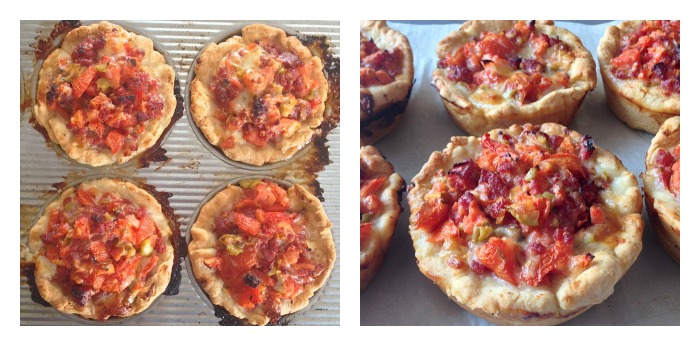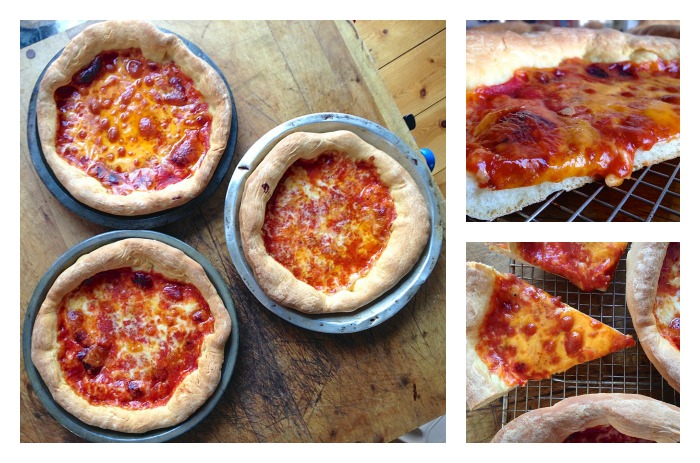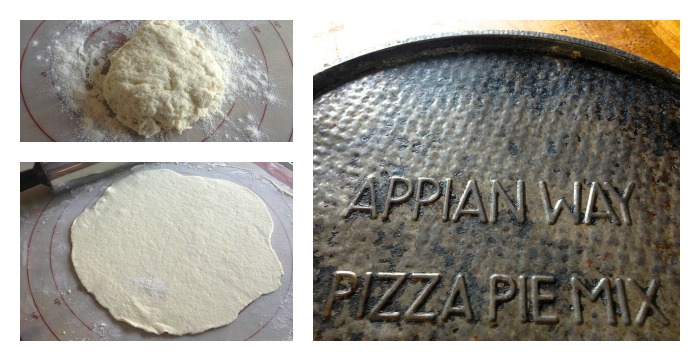


 The King Arthur Flour Company marks its 225th anniversary this year. And we're celebrating by exploring some of America's favorite recipes, decade by decade, starting in 1900. Join us on this fascinating stroll through American food history.
The King Arthur Flour Company marks its 225th anniversary this year. And we're celebrating by exploring some of America's favorite recipes, decade by decade, starting in 1900. Join us on this fascinating stroll through American food history.
Pizza.
Admit it – you've just gone all melty inside: exactly like the mozzarella on top of your favorite sausage and pepperoni pie.
Pizza has been a lifelong American cultural icon for all but our most senior readers. First offered at a few big-city Italian restaurants at the turn of the 20th century, pizza started to come into its own at Chicago's Pizzeria Uno – the first restaurant built around this "foreign dish" – in 1943.
Nationally franchised takeout pizza was born in the heart of Boomer childhood; Pizza Hut in 1958, Little Caesars in 1959, and Domino's in 1960. And from then on, pizza was an established part of the American culinary landscape.
But what about homemade pizza? When did Americans start making their own pizza at home, from scratch, rather than piling into the Studebaker to drive down to the pizza parlor for takeout?
According to my favorite food-history source, The Food Timeline, the first known American cookbook pizza recipe appeared in 1936, in Specialita Culinarie Italiane, 137 Tested Recipes of Famous Italian Foods.
But it wasn't until nearly 10 years later that pizza made it out of its niche Italian category, and into the American mainstream.
Ah, 1945. American GI's were coming home from Europe, and some of them returned with a new-found love for Italian food – such as pizza, at that time a treat available only at Italian restaurants. But if America's husbands and sons wanted pizza, pizza they'd have – and wives everywhere started searching for pizza recipes.
Pizza wasn't yet in mainstream cookbooks like Joy of Cooking – the "Bible" of that era.
But magazines? The August, 1945 issue of Gourmet magazine – at that time just 5 years old – featured Miss Rheingold inside the front cover; and this recipe in the reader request section:
Apparently, in trying to envision an American "pizza pie," Gourmet's recipe writers started with pie plates and pie pastry (or biscuit dough, as an option).
And the filling? These "authentic" Italian ingredients: salami and anchovies, garlic and olives. Tomatoes, and "Italian cheese."
I had a hard time imagining salami and anchovies playing nicely together, so decided I'd best make the recipe and judge for myself.
"Six individual 4" pies," the recipe says. Well, who has six 4" pie plates?
Bingo! Our hamburger bun pan makes six 4" pies – apple, berry... or pizza.
Since biscuit dough is SO easy, especially when you use self-rising flour, I chose that over pie pastry. Starting with 3 cups self-rising flour, I added 1 teaspoon salt, and 1 cup light cream, enough to make a dough that was soft, yet not too sticky to roll.
I divided the dough into 6 pieces; rolled them out; nestled them into the pan.
Next, I deconstructed the filling. "3 large, ripe, red tomatoes" – how large? I hazarded a guess that tomatoes back then weren't as large as they are now, and decided on a pound of tomatoes: which is probably 2 large tomatoes (or 7 plum tomatoes, which is what I bought since they were on sale).
Everything into a bowl. Chop-chop. Mounded into the crusts (which I'd baked a couple of minutes to "set," as directed – though in retrospect, this step seems unnecessary; it didn't even melt the butter).
 The recipe's called-for 15 to 18 minutes in a 350°F oven turned into 25 to 30 minutes at 400°F.
The recipe's called-for 15 to 18 minutes in a 350°F oven turned into 25 to 30 minutes at 400°F.
And the result?
Surprisingly tasty.
Rather than being overwhelmingly "anchovy-ish," the fish simply added welcome saltiness.The tomatoes softened, the cheese melted, and all in all, these were nice little quiche/pizza clones. Not something I'd make on a regular basis; but if you like food history, they're an interesting trip.
 By 1954, the first yeast-crust pizzas were making an appearance, as evidenced in The Betty Furness Westinghouse Cookbook.
By 1954, the first yeast-crust pizzas were making an appearance, as evidenced in The Betty Furness Westinghouse Cookbook.
Wait a minute — you've never heard of Betty Furness? Check her out in this vintage Westinghouse video; her pizza was pretty darned good!
...despite its canned soup sauce.
Check out the printed recipe above. Notice that accent in "orégano"? This ubiquitous herb was considered a new and "dashing" ingredient in American kitchens back then, having only recently made its way over from Italy – like pizza.
Since Betty, like Gourmet, is thinking of pizza as pie, I figured I'd best use my oldest pie pan – this yard-sale treasure, gifted to me from my fellow blogger, MJ.
 As for the crust – hot roll mix?
As for the crust – hot roll mix?
It's still around today; a glance at the label ingredients, and it was an easy replication:
3 ¾ cups (15 ¾ ounces) King Arthur Unbleached All-Purpose Flour
2 teaspoons instant yeast
1 ½ teaspoons salt
1 large egg
2 tablespoons olive oil
2 tablespoons Baker's Special Dry Milk or nonfat dry milk
1 cup lukewarm water
Mix everything together, knead, let rise for an hour or so, and there you have it: 1 package hot roll mix, prepared.
From that point on, the recipe is a cinch to follow. Divide the roll mix in thirds; roll each piece about 1/8" thick; and place in 9" pie pans (don't bother greasing the pans). Do, however, brush the crusts with olive oil – because, why not? It'll help them brown, and adds both crispness, and flavor.
Next: that totally '50s filling.
Condensed tomato soup, made Italian by adding "orégano" and garlic.
Cheddar cheese.
That's it. Although I wasn't sure about yellow vs. white cheddar, or thick vs. thin-sliced. So I tried both. The white cheddar won.
Thirty minutes in a 425°F oven was just right.
That's a good-looking kind-of-pizza, isn't it?
 And it's surprisingly tasty, too.
And it's surprisingly tasty, too.
Though the filling-to-crust ratio skews towards the crust side, the tomato soup is a good choice: thick, rich tasting, not at all acidic but rather nicely/barely sweet.
And while the quarter-pound of cheddar on each pizza did exude quite a bit of oil as it baked, said excess oil was easily sopped up with a paper towel before serving.
Verdict: I'd definitely make these again. My husband and his fellow trail volunteers absolutely devoured them – chainsaws momentarily silenced, replaced by happy munching.
Next: at last – a flat, round pizza!
This 1961 recipe comes from a cookbook featuring Amy Vanderbilt, "the nation's foremost etiquette authority."
(I wonder who 2014's foremost etiquette authority is? Methinks America used to put a lot more emphasis on etiquette.)
Well, we've progressed from Gourmet's "pastry or biscuit dough;" but as far as a yeast-based crust, we've regressed from 1954's hot roll mix, back to biscuits – more's the pity.
But it's understandable: this era is all about convenience, and Bisquick ("packaged biscuit mix") had been the busy housewife's best friend since the 1930s.
Pizza with a Bisquick crust? Sounds like '60s home ec to me.
Thankfully, I was able to use 2 cups of our own King Arthur Flour Baking Mix. The 2/3 cup milk called for in Amy's recipe brought the dough together just fine.
 And the topping: oh, my, we're back to anchovies and meat – canned pork sausage (dare I think Vienna?). I substituted half a pound of cooked, crumbled breakfast sausage.
And the topping: oh, my, we're back to anchovies and meat – canned pork sausage (dare I think Vienna?). I substituted half a pound of cooked, crumbled breakfast sausage.
We've also progressed from tomato soup, to tomato sauce. Orégano – complete with its Continental é – is back. But talk about regression: cheddar cheese, make way for for Velveeta!
 I rummaged through my "veteran" pans once again, and pulled out my mom's Appian Way pizza pan – which must be 50 years old. I'll bet it was bright silver to begin with – but its well-earned darker color yields a lovely, crisp crust.
I rummaged through my "veteran" pans once again, and pulled out my mom's Appian Way pizza pan – which must be 50 years old. I'll bet it was bright silver to begin with – but its well-earned darker color yields a lovely, crisp crust.
From here, it's easy as pie: divide the dough in half, roll each half into a circle, and place on your pans.
`Top with sausage, then cheese, then tomato sauce, which you've combined with the anchovies and oregano.
A bit different order than we're used to, eh?
Bake as directed: about 18 minutes at 425°F.
 Crumbly/tender biscuit crust, anchovy-laced tomato sauce, processed American cheese... As I said, home ec pizza! Though I'm sure the home ec kitchen at my alma mater, Central Junior High in Hingham, MA, never, ever saw a can of anchovies.
Crumbly/tender biscuit crust, anchovy-laced tomato sauce, processed American cheese... As I said, home ec pizza! Though I'm sure the home ec kitchen at my alma mater, Central Junior High in Hingham, MA, never, ever saw a can of anchovies.
Would I make this again?
No. Sorry, Amy – I faded away somewhere between the odd crust and the processed cheese.
But did it disappear anyway? Of course. Hot bread and melted cheese, even when it's biscuits and Velveeta, is hard to resist.
So, that completes our journey through the early days of homemade American pizza. What's your favorite childhood pizza memory? Please share in comments, below.
I couldn't resist leaving you with a photo of another "historic American" pizza:
The original Italian restaurant pizza (also pictured at the very top of this post): early 20th century New York/New Haven super-thin-crust pizza, topped with marinara; mozzarella or Romano; garlic and, as an option, sliced tomatoes. Our recipe for Thin-Crust Pizza is a worthy clone.
Next month: Read how Betty, Amy, anchovies, and cream of tomato soup give way to Jeremiah, Alice, Wolfgang – and smoked salmon, goat cheese, and artichokes. Don't miss our next installment in America's Love Affair with Pizza: The 70s-'80s revolution. And our series finale, Smackdown in the Freezer Aisle.